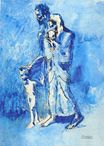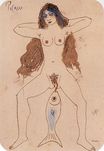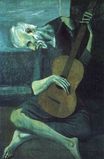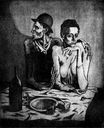©Пабло Пикассо - Старый слепой гитарист 1903
 |
 |
 |
 |
 |
 |
 |

Старый слепой гитарист 1903
121x82см холст/масло
Art Institute of Chicago, Chicago, IL, USA
The image is only being used for informational and educational purposes
<< Previous G a l l e r y Next >>
From Art Institute of Chicago:
Pablo Picasso produced The Old Guitarist, one of his most haunting images, while working in Barcelona. In the paintings of his Blue Period (1901–04), of which this is a prime example, Picasso restricted himself to a cold, monochromatic blue palette; flattened forms; and the emotional, psychological themes of human misery and alienation, which are related to the Symbolist movement and the work of such artists as Edvard Munch.
Picasso presented The Old Guitarist as a timeless expression of human suffering. The bent and sightless man holds his large, round guitar close to him; its brown body is the painting’s only shift in color. The elongated, angular figure of the blind musician relates to Picasso’s interest in the history of Spanish art and, in particular, the great sixteenth-century artist El Greco. Most personally, however, the image reflects the struggling twenty-two-year-old Picasso’s sympathy for the plight of the downtrodden; he knew what it was like to be poor, having been nearly penniless during all of 1902. His works from this time depict the miseries of the destitute, the ill, and the outcasts of society.
— Entry, The Essential Guide, 2013, p. 245.